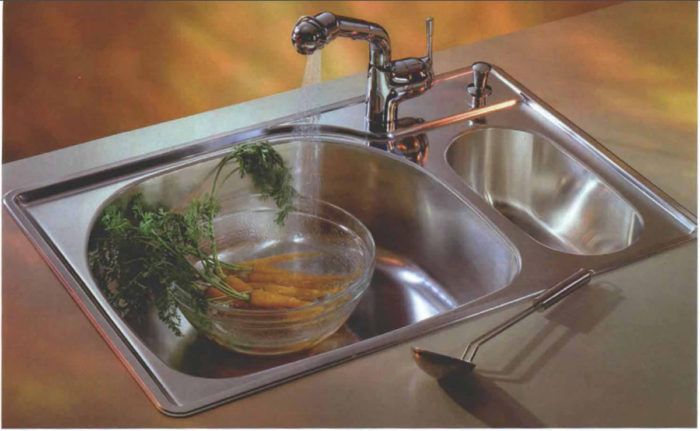Choosing a Kitchen Sink
There are lots of shapes, sizes, materials, and accessories available today, but it's still a good idea to get what suits your needs.

Synopsis: This is a look at different types of kitchen sinks, with a discussion of cost, durability, and performance.
When I was six years old, my family moved into a brand-new, state-of-the-art ranch house in a treeless subdivision freshly scraped out of a cotton field. By state of the art, I mean the house had built-in kitchen appliances that matched the kitchen sink, which was a gleaming copper-tone brown unit set into a gold-flecked, turquoise Formica countertop.
Actually, that sink wasn’t anything special. In those days, almost every new sink in every new subdivision was either copper-tone brown, avocado green, or snowdrop white; had two bowls; and was cast iron or enamel on steel. (I’m sure there probably were lots of stainless-steel sinks, too, but just how much is a six-year-old expected to notice?)
As ordinary as it was, that copper-tone sink served the family well. My mother washed vegetables, scrubbed pots and pans, soaked dishes and polished silver in that sink. She also delivered the occasional haircut to an uncooperative head held over the sink.
That was a generation ago. Lifestyles, tastes, and even the way people cook have changed substantially in that time. Sure, sinks are still used for washing things and filling things and preparing things. They’re still required to take a good beating. The kitchen sink remains just as versatile and is still the most frequently used “center of activity” in the home, according to the National Kitchen and Bath Association (NKBA). But much has changed. For one thing, sinks don’t just come in two-bowl copper-tone brown, avocado green, or snowdrop white anymore; nor are they made only of ferrous metals.
What’s important in a sink?
Let’s say you’re in the market for a sink. And for the sake of argument, let’s say you’ve found a sink you like, one that looks good and that comes in a color to match your collection of Elvis commemorative plates. Besides looks, what else should you consider before plunking down hundreds of dollars?
If you’re installing the sink yourself, you should consider ease of installation. For example, there’s a lot more to installing an underhung, or undermount, sink than there is to installing a self-rimming sink or drop-in sink, which basically involves laying a bead of caulk and setting the sink into a hole in the counter. And unless you’ve had the training, I wouldn’t recommend even trying to install an integral sink of solid-surface material, such as Wilsonart’s Gibralter or DuPont’s Corian.
Before you buy, you’ll also want to consider the durability of the sink material. Will it chip, dent, stain, rattle, tarnish, scratch, crack, rust, blister, or mar? And how quiet is it when water floods into the basin or runs down the drain?
For more photos and details, click the View PDF button below:
Fine Homebuilding Recommended Products
Fine Homebuilding receives a commission for items purchased through links on this site, including Amazon Associates and other affiliate advertising programs.

All New Kitchen Ideas that Work

Get Your House Right: Architectural Elements to Use & Avoid

Not So Big House

























